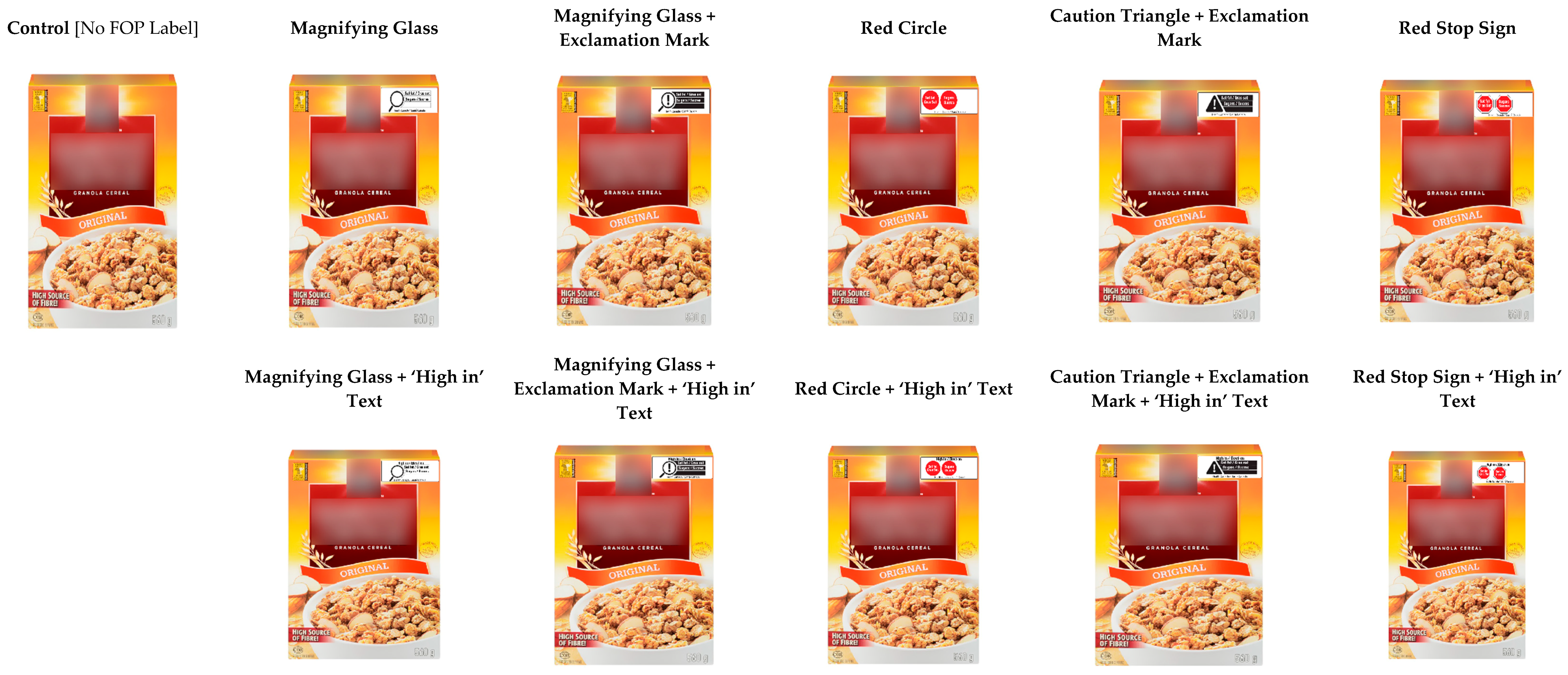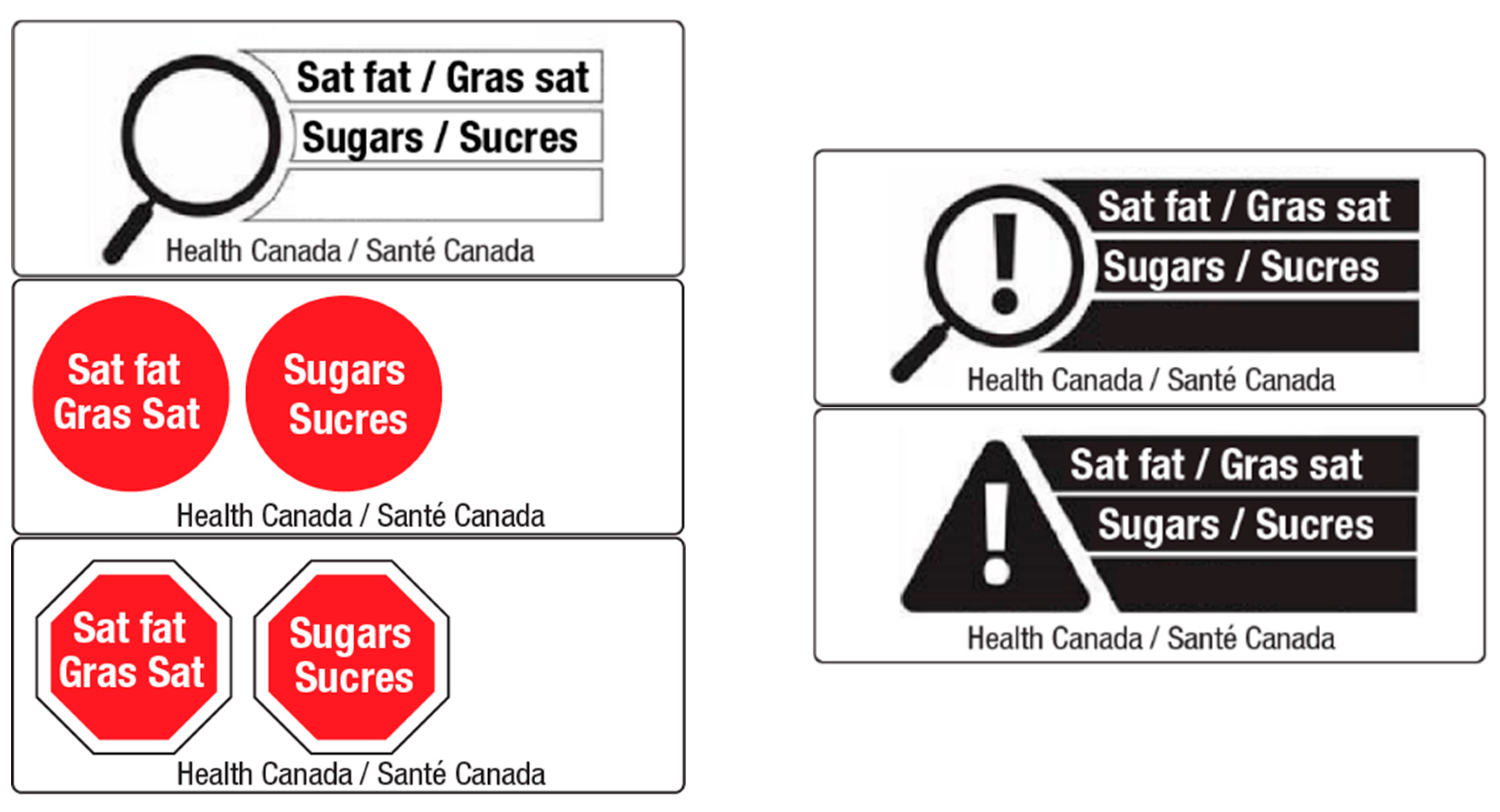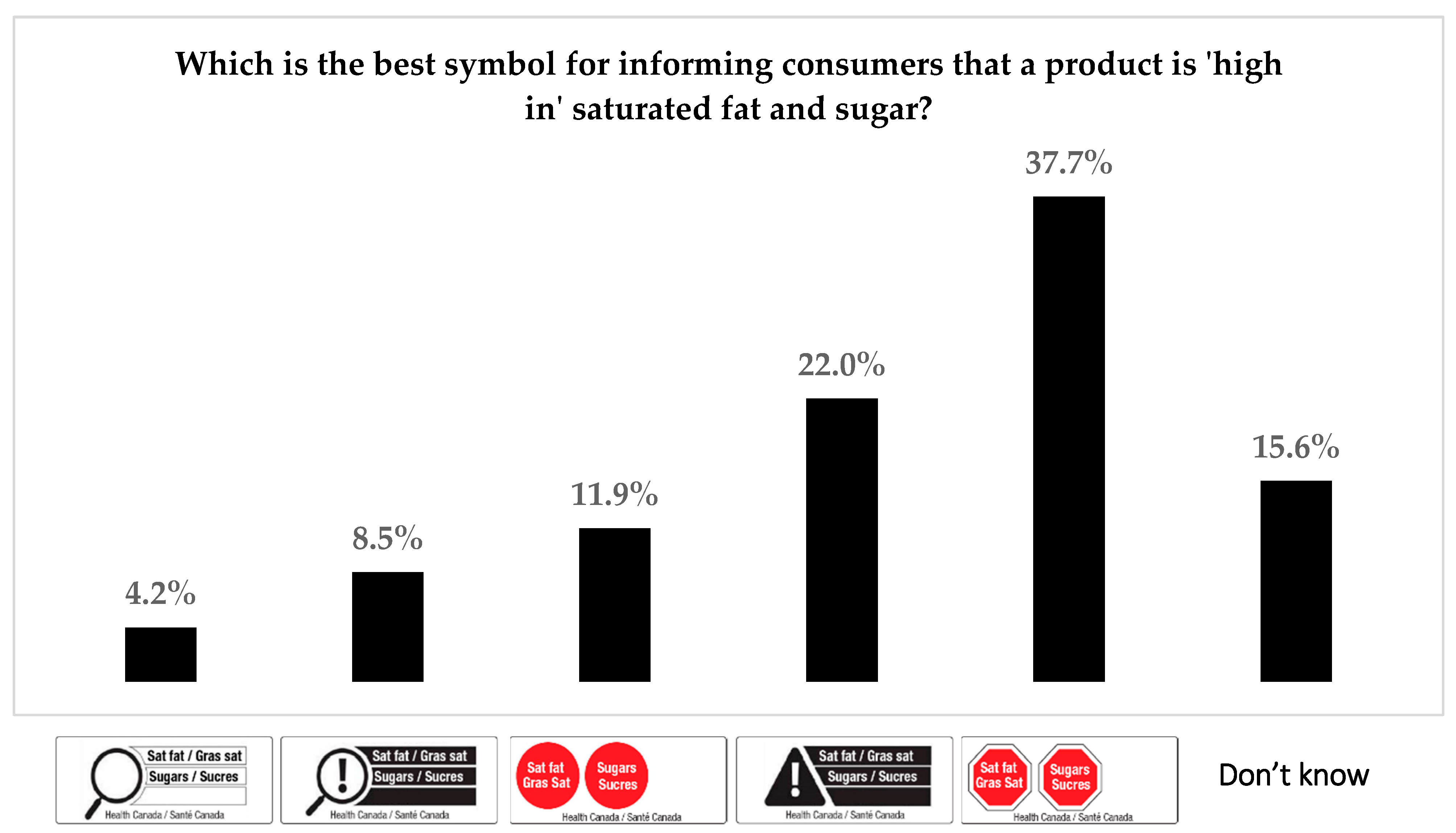The Impact of Front-of-Package Label Design on Consumer Understanding of Nutrient Amounts
Abstract
1. Introduction
2. Materials and Methods
3. Data Analysis
4. Results
4.1. Functional Understanding of FOP Labels (Experimental Task)
4.2. Perceived Effectiveness of FOP Designs
5. Discussion
6. Strengths and Limitations
7. Conclusions
Supplementary Materials
Author Contributions
Funding
Conflicts of Interest
References
- Forouzanfar, M.H.; Alexander, L.; Anderson, H.R.; Bachman, V.F.; Biryukov, S.; Brauer, M.; Burnett, R.; Casey, D.; Coates, M.M.; Cohen, A.; et al. Global, regional, and national comparative risk assessment of 79 behavioural, environmental and occupational, and metabolic risks or clusters of risks in 188 countries, 1990–2013: A systematic analysis for the Global Burden of Disease Study 2013. Lancet 2015, 386, 2287–2323. [Google Scholar] [CrossRef]
- Healthy Diet: Key Facts. Available online: http://www.who.int/news-room/fact-sheets/detail/healthy-diet (accessed on 24 September 2018).
- Statistics Canada. Adult Body Mass Index: Health Canada Classification. Table: 13-10-0323-01. Available online: https://www150.statcan.gc.ca/t1/tbl1/en/tv.action?pid=1310032301 (accessed on 24 September 2018).
- Obesity and Overweight. Available online: http://www.who.int/news-room/fact-sheets/detail/obesity-and-overweight (accessed on 24 September 2018).
- Moubarac, J.-C.; Batal, M.; Martins, A.P.B.; Claro, R.; Levy, R.B.; Cannon, G.; Monteiro, C. Processed and ultra-processed food products: Consumption trends in Canada from 1938 to 2011. Can. J. Diet. Pract. Res. 2014, 75, 15–21. [Google Scholar] [CrossRef] [PubMed]
- Campos, S.; Doxey, J.; Hammond, D. Nutrition labels on pre-packaged foods: A systematic review. Public Health Nutr. 2011, 14, 1496–1506. [Google Scholar] [CrossRef] [PubMed]
- Goodman, S.; Hammond, D.; Pillo-Blocka, F.; Glanville, T.; Jenkins, R. Use of Nutritional Information in Canada: National trends between 2004 and 2008. J. Nutr. Educ. Behav. 2011, 43, 356–365. [Google Scholar] [CrossRef] [PubMed]
- Canadian Foundation for Dietetic Research (CFDR) Presents Tracking Nutrition Trends 2013. Available online: https://www.cfdr.ca/Downloads/CCFN-docs/TNT-2013-Summary-Report.aspx (accessed on 24 September 2018).
- Misra, R. Knowledge, attitudes, and label use among college students. J. Am. Diet. Assoc. 2007, 107, 2130–2134. [Google Scholar] [CrossRef] [PubMed]
- Smith, S.C.; Taylor, J.G.; Stephen, A.M. Use of Food Labels and Beliefs about Diet-Disease Relationships among University Students. Public Health Nutr. 2007, 3, 175–182. [Google Scholar] [CrossRef]
- Sullivan, A.D. Determining how low-income food shoppers perceive, understand, and use food labels. Can. J. Diet. Pract. Res. 2003, 64, 25–27. [Google Scholar] [CrossRef] [PubMed]
- Keller, S.B.; Landry, M.; Olson, J.; Velliquette, A.M.; Burton, S.; Andrews, J.C. The Effects of Nutrition Package Claims, Nutrition Facts Panels, and Motivation to Process Nutrition Information on Consumer Product Evaluations. J. Public Policy Mark. 1997, 16, 256–269. [Google Scholar]
- Garretson, J.A.; Burton, S. Effects of Nutrition Facts Panel Values, Nutrition Claims, and Health Claims on Consumer Attitudes, Perceptions of Disease-Related Risks, and Trust. J. Public Policy Mark. 2000, 19, 213–227. [Google Scholar] [CrossRef]
- Balasubramanian, S.K.; Cole, C. Consumers’ search and use of nutrition information: The challenge and promise of the nutrition labelling and education act. J. Mark. 2002, 66, 112–127. [Google Scholar] [CrossRef]
- Lindhorst, K.; Corby, L.; Roberts, S.; Zeiler, S. Rural consumers’ attitudes: Towards nutrition labelling. Can. J. Diet. Pract. Res. 2007, 68, 146–149. [Google Scholar] [CrossRef] [PubMed]
- Silayoi, P.; Speece, M. Packaging and purchase decisions: An exploratory study on the impact of involvement level and time pressure. Br. Food J. 2004, 106, 607–628. [Google Scholar] [CrossRef]
- Reid, D.J.; Hendricks, S. Consumer Awareness of Nutrition Information on Food Package Labels. J. Can. Diet. Assoc. 1993, 54, 127–131. [Google Scholar]
- Levy, A.S.; Fein, S.B. Consumers’ ability to perform tasks using nutrition labels. J. Nutr. Educ. 1998, 30, 210–217. [Google Scholar] [CrossRef]
- Rothman, R.L.; Housam, R.; Weiss, H.; David, D.; Gregory, R.; Gebretsadik, T.; Shintani, A.; Elasy, T.A. Patient understanding of food labels: The role of literacy and numeracy. Am. J. Prev. Med. 2006, 31, 391–398. [Google Scholar] [CrossRef] [PubMed]
- Strategic Counsel. Final Report—Canadians’ Understanding and Use of the Nutrition Facts Table: Survey Results; POR 031–10(HCPOR-10-06); Health Canada: Ottawa, ON, Canada, 2012.
- Vanderlee, L.; White, C.M.; Bordes, I.; Hobin, E.P.; Hammond, D. The efficacy of sugar labeling formats: Implications for labeling policy. Obesity 2015, 23, 2406–2413. [Google Scholar] [CrossRef] [PubMed]
- Nayga, R.M.; Lipinski, D.; Savur, N. Consumers’ use of nutritional labels while food shopping and at home. J. Consum. Aff. 1998, 32, 106–120. [Google Scholar] [CrossRef]
- Joint FAO/WHO Food Standards Programme Codex Committee on Food Labelling: Discussion Paper on Consideration of Issues Regarding Front-of-Pack Nutrition Labelling. Available online: http://www.fao.org/fao-who-codexalimentarius/sh-proxy/es/?lnk=1&url=https%253A%252F%252Fworkspace.fao.org%252Fsites%252Fcodex%252FMeetings%252FCX-714-44%252FWD%252Ffl44_07e.pdf (accessed on 24 September 2018).
- Kanter, R.; Vanderlee, L.; Vandevijvere, S. Front-of-package nutrition labelling policy: Global progress and future directions. Public Health Nutr. 2018, 21, 1399–1408. [Google Scholar] [CrossRef] [PubMed]
- Food Front-of-Package Nutrition Symbol Consumer Consultation. Available online: https://www.healthyeatingconsultations.ca/front-of-package (accessed on 24 September 2018).
- Consultation on Proposed Front-Of-Package Labelling. Available online: https://www.canada.ca/en/health-canada/programs/consultation-front-of-package-nutrition-labelling-cgi.html (accessed on 24 September 2018).
- SAGE Research Corporation. Consumer Opinions of “High in” Front of Pack Labelling Strategies: Final Report. Prepared for Health Canada. Available online: http://epe.lac-bac.gc.ca/100/200/301/pwgsc-tpsgc/por-ef/health/2017/060-16-e/report.pdf (accessed on 24 September 2018).
- Institute of Medicine. Front-of-Package Nutrition Rating Systems and Symbols: Promoting Healthier Choices; The National Academies Press: Washington, DC, USA, 2012; pp. 1–180. ISBN 978-0-309-21826-9. Available online: https://www.nap.edu/catalog/13221/front-of-package-nutrition-rating-systems-and-symbols-promoting-healthier (accessed on 24 September 2018). [CrossRef]
- Becker, M.W.; Bello, N.M.; Sundar, R.P.; Peltier, C.; Bix, L. Front of pack labels enhance attention to nutrition information in novel and commercial brands. Food Policy 2015, 56, 76–86. [Google Scholar] [CrossRef] [PubMed]
- Becker, M.W.; Sundar, R.P.; Bello, N.; Alzahabi, R.; Weatherspoon, L.; Bix, L. Assessing attentional prioritization of front-of-pack nutrition labels using change detection. Appl. Ergon. 2016, 54, 90–99. [Google Scholar] [CrossRef] [PubMed]
- Borgmeier, I.; Westenhoefer, J. Impact of different food label formats on healthiness evaluation and food choice of consumers: A randomized-controlled study. BMC Public Health 2009, 9, 184. [Google Scholar] [CrossRef] [PubMed]
- Kelly, B.; Hughes, C.; Chapman, K.; Louie, J.C.; Dixon, H.; Crawford, J.; King, L.; Daube, M.; Slevin, T. Consumer testing of the acceptability and effectiveness of front-of-pack food labelling systems for the Australian grocery market. Health Promot. Int. 2009, 24, 120–129. [Google Scholar] [CrossRef] [PubMed]
- Babio, N.; López, L.; Salas-Salvadó, J. Capacity analysis of health food choice by reference to consumers in two models of nutritional labeling; crossover study. Nutr. Hosp. 2013, 28, 173–181. [Google Scholar] [CrossRef] [PubMed]
- Babio, N.; Vicent, P.; López, L.; Benito, A.; Basulto, J.; Salas-Salvadó, J. Adolescents’ ability to select healthy food using two different front-of-pack food labels: A cross-over study. Public Health Nutr. 2014, 17, 1403–1409. [Google Scholar] [CrossRef] [PubMed]
- Arrúa, A.; Machín, L.; Curutchet, M.R.; Marítnez, J.; Antúnez, L.; Alcaire, F.; Giménez, A.; Ares, G. Warnings as a directive front-of-pack nutrition labelling scheme: Comparison with the Guideline Daily Amount and traffic-light systems. Public Health Nutr. 2017, 20, 2308–2317. [Google Scholar] [CrossRef] [PubMed]
- Hammond, D.; Vanderlee, L.; Hobin, E.P.; White, C.M.; Bordes, I. Nutrition Facts Table: Consumer Perceptions among Young Adults; Health Canada: Ottawa, ON, Canada, 2014.
- Antúnez, L.; Giménez, A.; Maiche, A.; Ares, G. Influence of interpretation aids on attentional capture, visual processing, and understanding of front-of-package nutrition labels. J. Nutr. Educ. Behav. 2015, 47, 292–299. [Google Scholar] [CrossRef] [PubMed]
- Wogalter, M.S.; Conzola, V.C.; Smith-Jackson, T.L. Research-Based Guidelines for Warning Design and Evaluation. Appl. Ergon. 2002, 33, 219–230. [Google Scholar] [CrossRef]
- Hammond, D. Health warning messages on tobacco products: A review. Tob. Control 2011, 20, 327–337. [Google Scholar] [CrossRef] [PubMed]
- Ares, G.; Giménez, A.; Bruzzone, F.; Antúnez, L.; Sapolinski, A.; Vidal, L.; Maiche, A. Attentional capture and understanding of nutrition labelling: A study based on response times. Int. J. Food Sci. Nutr. 2012, 63, 679–688. [Google Scholar] [CrossRef] [PubMed]
- Antúnez, L.; Vidal, L.; Sapolinski, A.; Giménez, A.; Maiche, A.; Ares, G. How do design features influence consumer attention when looking for nutritional information on food labels? Results from an eye-tracking study on pan bread labels. Int. J. Food Sci. Nutr. 2013, 64, 515–527. [Google Scholar] [CrossRef] [PubMed]
- Siegrist, M.; Leins-Hess, R.; Keller, C. Which front-of-pack nutrition label is the most efficient one? The results of an eye-tracker study. Food Qual. Prefer. 2015, 39, 183–190. [Google Scholar] [CrossRef]
- Bix, L.; Sundar, R.P.; Bello, N.M.; Peltier, C.; Weatherspoon, L.J.; Becker, M.W. To see or not to see: Do front of pack nutrition labels affect attention to overall nutrition information? PLoS ONE 2015, 10, e0139732. [Google Scholar] [CrossRef] [PubMed]
- Acton, R.B.; Vanderlee, L.; Roberto, C.A.; Hammond, D. Consumer perceptions of specific design characteristics for front-of-package nutrition labels. Health Educ. Res. 2018, 33, 167–174. [Google Scholar] [CrossRef] [PubMed]
- Cowburn, G.; Stockley, L. Consumer understanding and use of nutrition labelling: A systematic review. Public Health Nutr. 2005, 8, 21–28. [Google Scholar] [CrossRef] [PubMed]
- Consumer Panels. Available online: http://www.nielsen.com/eu/en/solutions/capabilities/consumer-panels.html (accessed on 24 September 2018).
- International Food Policy Study: Technical Report—Wave 1 (2017). Available online: www.foodpolicystudy.com/methods (accessed on 24 September 2018).
- Front-of-Package Nutrition Labelling: 18 September 2017 Stakeholder Engagement Meeting. Available online: https://www.canada.ca/en/services/health/publications/food-nutrition/labelling-stakeholder-engagement-meeting-september-2017.html (accessed on 24 September 2018).
- Summary of Proposed Amendments Published in Canada Gazette, Part I: Nutrition Symbols, Other Labelling Provisions, Partially Hydrogenated Oils and Vitamin D. Available online: https://www.canada.ca/en/health-canada/programs/consultation-front-of-package-nutrition-labelling-cgi/summary-of-proposed-amendments.html (accessed on 24 September 2018).
- Acton, R.B.; Kirkpatrick, S.I.; Roberto, C.A.; Jones, A.C.; Hammond, D. Taxes and front-of-package labels improve the healthiness of beverage and snack purchases: A randomized experimental marketplace. Unpublished work. 2018. [Google Scholar]
- Sinclair, S.; Goodman, S.; Hammond, D. Socio-demographic differences in the comprehension of nutritional labels on food products. J. Nutr. Educ. Behav. 2013, 45, 767–772. [Google Scholar] [CrossRef] [PubMed]
- Ducrot, P.; Méjean, C.J.; Kesse-Guyot, E.; Touvier, M.; Fezeu, L.; Hercberg, S.; Péneau, S. Effectiveness of front-of-pack nutrition labels in French adults: Results from the NutriNet-Santé cohort study. PLoS ONE 2015, 10, e0140898. [Google Scholar] [CrossRef] [PubMed]
- Soederberg Miller, L.M.; Applegate, E.; Beckett, L.A.; Wilson, M.D.; Gibson, T.N. Age differences in the use of serving size information on food labels: Numeracy or attention? Public Health Nutr. 2017, 20, 786–796. [Google Scholar] [CrossRef] [PubMed]



| Variable | % (n) |
|---|---|
| Sex | |
| Male | 47.1% (5470) |
| Female | 52.9% (6147) |
| Age (years) | |
| 18–24 | 11.3% (1314) |
| 25–30 | 33.1% (3849) |
| 31–39 | 11.8% (1365) |
| 40–49 | 12.5% (1455) |
| 50–59 | 17.9% (2083) |
| 60–64 | 13.4% (1551) |
| Education level | |
| Low | 22.8% (2634) |
| Middle | 27.7% (3202) |
| High | 49.5% (5712) |
| Country | |
| USA | 33.2% (3855) |
| Canada | 7.0% (815) |
| Australia | 28.4% (3302) |
| UK | 31.4% (3645) |
| FOP Experimental Condition | Saturated Fat | Sugar |
|---|---|---|
| Control (no FOP Label) | 4.8% | 12.3% |
| Magnifying glass | ||
| No ‘high in’ text | 5.3% | 13.5% |
| ‘High in’ text | 6.5% | 14.5% |
| Magnifying glass + exclamation mark | ||
| No ‘high in’ text | 5.6% | 12.4% |
| ‘High In’ text | 8.9% | 17.0% |
| Red circle | ||
| No ‘high in’ text | 5.9% | 12.8% |
| ‘High in’ text | 10.3% | 17.4% |
| Triangle + exclamation mark | ||
| No ‘high in’ text | 7.8% | 15.0% |
| ‘High in’ text | 11.1% | 18.5% |
| Red stop sign | ||
| No ‘high in’ text | 8.8% | 15.8% |
| ‘High in’ text | 12.7% | 18.0% |
| Variable | Saturated Fat | Sugar |
|---|---|---|
| FOP label design | Χ2 (10) = 98.50 c | Χ2 (10) = 44.33 c |
| Control (ref) | - | - |
| Magnifying glass | 1.05 (0.71, 1.57) | 1.07 (0.82, 1.39) |
| Magnifying glass + ‘High in’ | 1.41 (0.97, 2.05) | 1.21 (0.94, 1.56) |
| Magnifying glass + Exclamation mark | 1.17 (0.79, 1.72) | 0.99 (0.76, 1.28) |
| Magnifying glass + Exclamation mark + ‘High in’ | 1.94 (1.36, 2.76) c | 1.43 (1.12, 1.82) b |
| Red circle | 1.22 (0.83, 1.79) | 1.03 (0.79, 1.33) |
| Red circle + ‘High in’ | 2.29 (1.61, 3.23) c | 1.48 (1.16, 1.89) b |
| Caution triangle + Exclamation mark | 1.68 (1.17, 2.41) b | 1.21 (0.94, 1.56) |
| Caution triangle + Exclamation mark + ‘High in’ | 2.51 (1.77, 3.55) c | 1.60 (1.25, 2.05) c |
| Red stop sign | 1.92 (1.34, 2.75) c | 1.34 (1.04, 1.72) a |
| Red stop sign + ‘High in’ | 2.95 (2.10, 4.15) c | 1.59 (1.25, 2.03) c |
| Sex | Χ2 (1) = 0.23 | Χ2 (1) = 1.29 |
| Male (ref) | - | - |
| Female | 1.04 (0.90, 1.19) | 1.06 (0.96, 1.18) |
| Age (years) | Χ2 (5) = 41.62 c | Χ2 (5) = 18.10 b |
| 18–24 (ref) | - | - |
| 25–30 | 1.07 (0.85, 1.35) | 0.79 (0.67, 0.95) a |
| 31–39 | 0.99 (0.75, 1.30) | 0.87 (0.71, 1.07) |
| 40–49 | 0.78 (0.59, 1.03) | 0.79 (0.64, 0.97) a |
| 50–59 | 0.63 (0.48, 0.83) b | 0.69 (0.57, 0.84) c |
| 60–64 | 0.56 (0.41, 0.76) c | 0.69 (0.56, 0.86) b |
| Education | Χ2 (2) = 6.33 a | Χ2 (2) = 22.43 c |
| Low (ref) | - | - |
| Middle | 1.03 (0.85, 1.24) | 1.00 (0.86, 1.16) |
| High | 1.26 (1.06, 1.49) a | 1.30 (1.13, 1.48) c |
| Country | Χ2 (3) = 64.98 c | Χ2 (3) = 190.20 c |
| USA (ref) | - | - |
| Canada | 2.74 (2.11, 3.55) c | 3.28 (2.70, 3.98) c |
| Australia | 1.03 (0.85, 1.24) | 0.99 (0.85, 1.14) |
| UK | 1.26 (1.06, 1.50) b | 1.55 (1.36, 1.77) c |
© 2018 by the authors. Licensee MDPI, Basel, Switzerland. This article is an open access article distributed under the terms and conditions of the Creative Commons Attribution (CC BY) license (http://creativecommons.org/licenses/by/4.0/).
Share and Cite
Goodman, S.; Vanderlee, L.; Acton, R.; Mahamad, S.; Hammond, D. The Impact of Front-of-Package Label Design on Consumer Understanding of Nutrient Amounts. Nutrients 2018, 10, 1624. https://doi.org/10.3390/nu10111624
Goodman S, Vanderlee L, Acton R, Mahamad S, Hammond D. The Impact of Front-of-Package Label Design on Consumer Understanding of Nutrient Amounts. Nutrients. 2018; 10(11):1624. https://doi.org/10.3390/nu10111624
Chicago/Turabian StyleGoodman, Samantha, Lana Vanderlee, Rachel Acton, Syed Mahamad, and David Hammond. 2018. "The Impact of Front-of-Package Label Design on Consumer Understanding of Nutrient Amounts" Nutrients 10, no. 11: 1624. https://doi.org/10.3390/nu10111624
APA StyleGoodman, S., Vanderlee, L., Acton, R., Mahamad, S., & Hammond, D. (2018). The Impact of Front-of-Package Label Design on Consumer Understanding of Nutrient Amounts. Nutrients, 10(11), 1624. https://doi.org/10.3390/nu10111624






